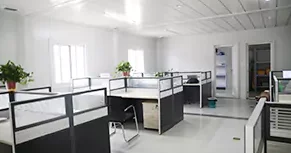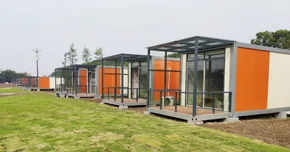How Modular Buildings Support Smarter Urban Planning
How Modular Buildings Support Smarter Urban Planning
Cities are getting busier every year. More people want to live close to work, travel for leisure, and explore unique destinations. But traditional construction just can’t keep up with that pace. It takes too long, costs keep rising, and half the time local communities are left waiting for the promised schools, housing, or tourist infrastructure. This is where modular buildings quietly change the game.
Companies like GS Housing, with more than 20 years in modular design and manufacturing, are showing how prefabricated solutions can be part of smarter, faster, and greener urban planning. Their Multi-Functional Flat Packed Container Houses are a good example—designed for versatility, quick deployment, and durability, they’ve been used everywhere from worker camps to tourist resorts. Let’s break down how this approach fits into modern city development.

How Do Modular Buildings Improve City Space Management
Compact Footprints With Vertical Expansion
Land is always scarce in cities. Instead of sprawling out, modular systems make it easier to build upwards. Flat packed container houses can be stacked up to three floors, creating compact hotels, pop-up apartments, or small commercial hubs without eating into valuable ground space. In Beijing, GS Housing supplied container classrooms that fit perfectly into a school’s limited land area, stacking units into double-storey blocks instead of spreading them wide.
Relocatable Units For Changing Land Use
One advantage planners like is flexibility. Land zoning can change quickly—an empty lot today might become a transit station tomorrow. Modular houses can be relocated without tearing everything down. The whole unit can be moved intact, saving cost and avoiding waste. That’s a big deal for city councils who can’t predict every long-term shift.
Integration Into Mixed Urban Functions
Modular design also makes it easier to combine uses. A group of units can serve as offices during the week and transform into temporary exhibition spaces during city events. This adaptability is increasingly important in cities where the same block of land may host tourists, students, and businesses all within a year.
Why Are Modular Solutions Effective For Tourist Accommodation
Flexible Design For Resorts And Campsites
Tourism is seasonal. A beach town in summer may need triple the beds compared to winter. Resorts using modular tourist cabins can add or remove capacity quickly. GS Housing’s flat packed container houses are often used as holiday cabins in grasslands, near beaches, or in eco-tourism parks. Interiors can be customized to look rustic, minimalist, or boutique.
Comfortable Interiors With Pre-Fitted Utilities
Unlike the previous kind of empty temporary housing, these container units are equipped with electricity. That means a tourist arriving at a newly built modular resort doesn’t feel like they’re staying in “temporary housing”—they get a warm shower, proper climate control, and the sense of being in a modern guestroom.
Quick Deployment In Scenic Or Remote Areas
One underrated factor: speed. A tourist project in a mountain or desert location often faces harsh building conditions. With modular houses, 80–90% of the work is done in the factory. Local teams just assemble on site. A 50-unit resort can be set up in weeks instead of months. That’s the difference between missing a high season and actually hosting guests on time.
What Makes GS Housing’s Flat Packed Container Houses Suitable For Tourism
Multi-Functional Layouts For Guest Needs
Each unit can be configured as a single room, a family suite, or connected together for larger villas. Common functions like bathrooms, and balconies can be integrated directly. Resorts that want to attract younger travelers even convert them into “Instagram-friendly” stays—bright facades, glass walls, or rooftop terraces.
Safe And Durable Performance In All Climates
GS Housing’s container houses are tested for seismic resistance (up to magnitude 8) and can withstand typhoon-level winds. For coastal resorts, that’s non-negotiable. A resort in Hainan province used these modules because they are corrosion-resistant and could handle humid, salty air. Guests don’t care about the engineering, but they care about sleeping in a cabin that doesn’t leak during a storm.
Sustainable And Reusable Construction Approach
Tourism often faces scrutiny about its environmental impact. These modular houses reduce waste by about 70% compared with traditional construction. When one tourist project ends, the same units can be refurbished and redeployed elsewhere—turning sunk costs into a portable asset.
How Do Modular Buildings Enhance Sustainability In Urban Planning
Reduced Waste Through Factory Production
Factory-controlled cutting and assembly reduce off-cuts and errors. GS Housing’s production lines cut concrete waste by 60% and water usage by 50%. That’s not just good for the planet; it also saves city budgets on landfill and disposal fees.
Energy-Saving Materials And Insulation Systems
Part of the Oriental GS Housing has insulation effect。In plain language: they stay cool in summer, warm in winter, and safe from fire hazards. Cities that promote energy-efficient hotels and housing can meet policy goals faster with such modules.
Reusable Modules For Circular Urban Development
Rather than demolishing old buildings, modular units can be dismantled, refurbished, and rebuilt elsewhere.
Can Modular Construction Support Urban Emergency And Seasonal Demands
Rapid Assembly For Temporary Shelters
Disasters strike without warning. GS Housing has built thousands of emergency shelters in China during floods, earthquakes, and even during COVID-19. Flat packed houses can be deployed within days, with sanitation and electricity already in place.
Expandable Spaces For Peak Travel Seasons
Tourist towns can double their accommodation capacity during festivals by adding modular cabins. Afterward, those units can be stored or moved to other sites. It’s a cost-effective way to handle temporary peaks without overbuilding.
Mobility Across Different Urban Locations
Because units can be shipped by road, rail, or sea, they are suited for both inner cities and remote areas. This mobility lets city planners test out new development zones before committing to permanent infrastructure.
How Do Modular Tourist Facilities Benefit Local Communities
Affordable Lodging Options For Wider Visitors
Not every traveler can afford luxury hotels. Modular tourist cabins provide clean, safe, and affordable accommodation. That means local tourism attracts more budget-conscious visitors, not just the premium market.
Opportunities For Cultural And Creative Spaces
Some resorts use GS Housing units as art studios, small cafés, or cultural halls. This creates more local business opportunities and adds character to tourist spots. It’s not just about beds—it’s about building micro-communities around tourism.

Added Value To Regional Tourism Economy
By setting up quickly, modular facilities help small towns capture tourism income they might otherwise miss. Think of a riverside town that hosts a yearly dragon boat festival. Without fast accommodation solutions, visitors might stay elsewhere. With modular lodging, the town keeps the income local.
Why Should Cities Partner With GS Housing For Modular Projects
Nationwide Production And Fast Delivery Network
With six factories across China—Foshan, Tianjin, Chengdu, Changzhou, Shenyang, and more—GS Housing can ship and install units nationwide. Production capacity reaches 200,000 units per year, meaning supply isn’t a bottleneck.
Integrated Service From Design To Installation
It’s not just about selling boxes. GS Housing provides engineering, on-site installation, and serviço de pós-vendas. Their installation teams have built over 2,000 projetos worldwide, often delivering in record time—such as 882 units for China’s 70th National Day parade in just 15 days.
Conclusão
Modular buildings are no longer a niche idea. They’re part of how smarter cities manage space, tourism, and sustainability. For tourist accommodation especially, GS Housing’s Multi-Functional Flat Packed Container Houses tick every box: fast to build, durable in tough climates, flexible in design, and reusable when plans change.
As urban planning becomes more complex, modular solutions give city leaders a practical tool to deliver results now—not ten years from now.
FAQ
Q1. Are modular tourist cabins comfortable for long stays?
A: Yes.The rooms are customized with wiring, pre-buried drains and modern indoor facilities that guests usually don’t notice are any different from a traditional hotel room.
Q2. How long does it take to set up a modular tourist resort?
A: A 50-unit project can often be completed within a few days, since factory production and site preparation happen in parallel.
Q3. Can GS Housing’s flat packed houses be reused in another location?
A: Absolutely. Units can be dismantled, transported, and reassembled with minimal damage. Many clients reuse them across multiple projects to save costs.



